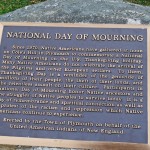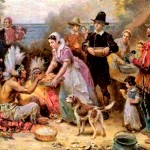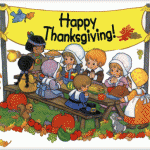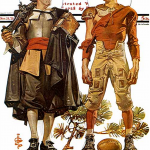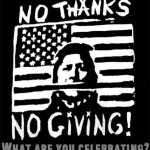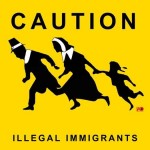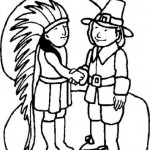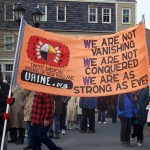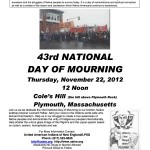Description:
This lesson asks students and teachers to critically examine the way the Thanksgiving holiday and its history are taught in K-12 schools and in popular media. Documents and videos are provided showing various contemporary Native American perspectives on Thanksgiving so that students can seek to understand the complexity of this so-called holiday and learn why some people consider it a day of mourning and rememberance for the genocide of Native American people.
Documents and Media:
A Thanksgiving Story that sheds light on its relationship to the genocide of Native Americans
A video from the 48th Annual National Day of Mourning at Plymouth, Massachusetts on November 23, 2017
http://www.youtube.com/watch?v=aiu4kUVXClo
A video with a perspective on Thanksgiving from activist and actor Russel Means
Thanksgiving Mourning- Lesson Plan http://www.tolerance.org/lesson/thanksgiving-mourning
The Wampanoag Side of the First Thanksgiving Story http://indiancountrytodaymedianetwork.com/article/the-wampanoag-side-of-the-first-thanksgiving-story-64076
United American Indians of New England – Thanksgiving: A National Day of Mourning for Indians http://www.uaine.org/dom.htm
A personal perspective on thanksgiving by Jacqueline Keeler a member of the Dineh Nation and the Yankton Dakota Sioux.
http://tiyospayenow.blogspot.com/2007/11/thanksgiving-hope-and-hidden-heart-of.html
Teaching about Thanksgiving. A detailed examination of Thanksgiving’s history originally written and developed by Cathy Ross, Mary Robertson, Chuck Larsen, and Roger Fernandes for the Highline School District in Washington State. Contains a bibliography, historical information and class project ideas.
http://www.ewebtribe.com/NACulture/articles/thanksgiving.html#story
Thanksgiving Teacher’s Guide from the Library of Congress (note its minimal mention of Native Americans)
teacher_guide_Thanksgiving – click link to download
LESSON PLAN:
Grade: 9-12 or College Level
Time: 3-5, 50 minute sessions
Introduction:
This lesson provides various videos and documents that tell the story of Thanksgiving from a Native American perspective, a perspective that is often overlooked in K-12 classes and popular media. A lesson plan from the Library of Congress and traditional Thanksgiving imagery are also provided to serve as places to compare and contrast. The complexity of perspectives in this collection requires that teachers and students research the views presented and discuss and share their reactions with each other. Native Americans are a vital and living part of our countries’ history and future and this lesson seeks to honor their voices and perspectives in order to confront, discuss and challenge the erroneous history and stereotypes of the classic Thanksgiving story.
California Visual Art Standards:
2.6 Create a two or three-dimensional work of art that addresses a social issue.
3.3 Identify and describe trends in the visual arts and discuss how the issues of time, place, and cultural influence are reflected in selected works of art.
4.1 Articulate how personal beliefs, cultural traditions, and current social, economic, and political contexts influence the interpretation of the meaning or message in a work of art.
5.2 Create a work of art that communicates a cross-cultural or universal theme taken from literature or history.
5.3 Compare and contrast the ways in which different media (television, newspapers, magazines) cover the same art exhibition.
Students will:
–Read texts and watch videos that tell the story of Thanksgiving from the perspective of various contemporary Native American people.
-Research the history of the Thanksgiving holiday and discuss its various interpretations and popular misconceptions.
-Create art and writing projects that interpret their findings.
-Discuss, debate and share their thoughts on the history of this holiday.
Materials:
1. Computers with internet access
2. LCD projector of TV with A/V capabilitiy
3. Internet connection for image searching or collection of images from students or teacher
4. Art materials or digital media equipment
Field Trip/Cultural Connection:
1. Arrange for a class family member or community member of Native American descent to give their perspective on Thanksgiving.
2. Arrange a field trip to a tribal museum or cultural center.
SEQUENCE OF INSTRUCTION
DAY 1 – CLASS DISCUSSION/CLASS ACTIVITY
1. Teacher will ask students what they know about Thanksgiving and its history.
2. Teacher will asks students what they know about Thanksgiving and its relationship to Native American people.
3. Students will share their prior knowledge and teacher will write down what students know on the board/computer.
4. Teacher will show one of the videos depicting a Native American perspective of Thanksgiving.
5. Teacher and students will discuss what they have watched and write down key points, historical names and new vocabulary words.
HOMEWORK:
Students will research some of the topics discovered in the videos and do a short written report or digital presentation (prezi, powerpoint, etc) on their findings. Topics may include- Genocide, Jamestown, Colonization, Massachusetts Bay Colony, Pilgrim, Indian, Massacre, Pequot, Pequot War, Slavery, Green Corn Festival, Wampanoag, Puritan, John Mason.
DAY2 – CLASS DISCUSSION/CLASS ACTIVITY
1. Teacher will start by asking students to share the information they have gathered in their homework.
2. Teacher and students will discuss their findings and begin to form a timeline and description of what they know of Thanksgiving.
3. Teacher will asks students to work in small groups or alone to continue to research on the topics covered. Teacher will note that there are various perspectives to consider in this history and that students should consider all sides and viewpoints when doing their research.
HOMEWORK:
Students are to continue working on their research from the previous homework. Students are to take their previous presentation and revise, edit and add to their work.
DAY 3-5 – CLASS DISCUSSION/CLASS ACTIVITY
1. If possible this would be a good day to have a Native American speaker in class or to take a field trip to a Native American cultural center.
2. Teacher will ask students to share their projects with the class. Teacher will ask students to ask questions and critique presentations as necessary.
3. Teacher will asks students to work in small groups or alone to create an art project based on their research. Possible project ideas are included below.
RESOURCES:
1.Center for World Indigenous Studies http://cwis.org/
2. Justice for Aboriginal Peoples (Canada) http://www.youtube.com/watch?v=r5DrXZUIinU
3. Native American history and cultural centers in Los Angeles http://losangeles.cbslocal.com/top-lists/best-ways-to-celebrate-native-american-history-and-culture-in-los-angeles/
4. Thanksgiving teaching suggestions http://www.educationworld.com/a_curr/curr040.shtml
5. Digital Drum – New media from an Aboriginal perspective http://www.digitaldrum.ca/about
6. Aboriginal People’s Television Network http://www.aptn.ca/
7. First Nations Experience- A new cable channel focusing on Native produced and focused content based in San Bernardino. ASK YOUR CABLE PROVIDED TO ADD THIS! This channel has some great educational content, I’m a big fan of it! http://fnx.org/
8. American Indian Genocide Museum http://www.aigenom.com/index.html
9. Transform Columbus Day http://www.transformcolumbusday.org/
10. Iroquois Confederacy and how it shaped the US Constitution http://fnx.org/blog/iroquois-confederacy-foundation-united-states-constitution
11. Addressing violence agains Native women in the Violent Against Women Act http://www.whitehouse.gov/blog/2012/05/14/addressing-violence-against-native-women-violence-against-women-act-reauthorization
12. Teaching Young Children about Native Americans http://www.ericdigests.org/1996-4/native.htm13. Contemporary stories from Native Communities in the Great Lakes area http://theways.org/about
Questions for Discussion:
- What did you learn about Thanksgiving that you didn’t know prior to our class?
- What perspective of the Thanksgiving story have you seen or heard of most often? Why do think this is?
- What is genocide? What’s the connection between Thanksgiving and genocide?
- Did all the Native American people in our media collection view Thanksgiving the same way? How did they differ or agree?
- What do you think of Thanksgiving? Has this lesson changed or affected your perspective?
- What is the connection between Thanksgiving and Colonization?
- Do you think there are stereotypes or racist depictions in the media shown in class?
- Do you have any family members or ancestors who belong to a Native American tribal group? If so what is the name of the tribe? What do you know about this history or tradition?
Project Ideas:
- Create a video, or 2-D work that shows your knowledge of Thanksgiving’s history. This could be a documentary, a poster, or a personal video diary.
- Visit a local Native American museum and cultural center and prepare a video or 2-D work on the information you have gathered.
- Interview a family or community member of Native American descent and describe their perspective on Thanksgiving.
- Research one of the tribal groups associated with the original Thanksgiving. Prepare a report, video or 2-D work that shares the information you have discovered.
- Organize a school event that coincides with Thanksgiving and share the information you have learned with your school community.
- Use the lesson plan provided in the resources to prepare a traditional Seneca dish or research another Native American dish to prepare.
- Create a 2-D or video project that shares information about your tribal ancestry.

